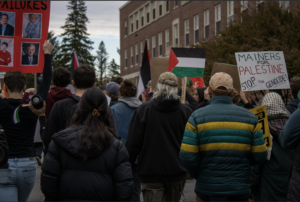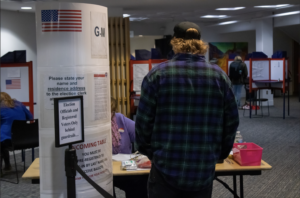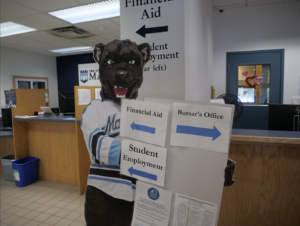The Southern Poverty Law Center (SPLC) has released a report that the number of hate groups in the United States has risen for the fourth year in a row. The United States is now home to 1,020 hate groups, including neo-Nazis, white supremacists, black nationalists, neo-confederates and the Ku Klux Klan. Proliferation of racist, xenophobic and generally violent political rhetoric from specific leaders of our country and the ability to recruit members, organize events and raise money on online platforms have contributed to the violent attitudes of the United States that fail to reject and even fosters the rise of hate groups.
The SPLC stated that the number of hate groups rose seven percent in 2018, and has been rising every year for the last four years. When deciding what determines a hate group, the SPLC cited that violence was not a prerequisite, but instead focused on organizations whose “leaders, activities, or statement of principles attacks an entire class of people,” according to the New York Times. Because of this, groups that are anti-LGBTQ, anti-immigration or anti-semitic but not necessarily physically violent are listed as hate groups as well.
The rise of hate groups is concurrent to the 30 percent increase in the number of hate crimes in 2018. The Anti-Defamation League Center on Extremism found that 50 people were killed by extremists in 2017, making it the fourth-deadliest year for domestic extremist related killings since 1970. Of these crimes, 73.3 percent of all extremist related fatalities can be linked to domestic right-wing extremists, while only 23.4 are attributed to Islamic extremists.
Geography and location play a large part in the conglomeration of hate groups. University of Utah researchers conducted a study that found hate is “concentrated in places that are poorer, less educated, less diverse and whiter, more religious, and more conservative.” These areas tend to see racial diversity, class divides and religious differences as “attacks” on their values and traditions. Fueled by fear, these areas turn to hateful rhetoric and actions to protect the way of life they believe is under threat.
But beyond geographic location, the turn to online platforms by extremist hate groups has proliferated their ability to cause harm, both physical and psychological. Joan Donovan, media manipulation research lead at Data and Society, a research institute, said in an interview with NPR that the ability to communicate through online platforms has made it easier for hate groups to recruit members and spread their message.
“I saw how these groups communicated and spread out to other spaces online with the intent of not telling people specifically that they were white supremacists, but they were really trying to figure out what young men were angry about and how they could leverage that to bring about a broad-based social movement,” said Donovan.
A recent and tragic example of a hate crime occurred in Charlottesville, Virginia, in the summer of 2017 when a member of the “Unite the Right” hate group drove his car into a group of protesters, fatally striking one individual and injuring many more. The original “Unite the Right” rally had been planned, organized and funded through online platforms such as PayPal, Facebook and the gamer chat app Discord.
After the Charlottesville attack, these platforms, along with others, went on a purging spree to ban or delete any message boards and profiles linked to the event or organization. Facebook banned pages such as “Right Wing Death Squad” and “White Nationalists United,” and Reddit banned a hard right community called “Physical Removal,” who had called the Charlottesville attack a “morally justified action,” according to the New York Times.
Beyond just online platforms, these extremist groups are also turning to video games to recruit young, primarily male, members. NPR published a story featuring a father, John, whose last name was withheld to protect privacy, who had found neo-Nazi propaganda print-outs in his son’s room. His son was an avid player of online multiplayer video games, where gamers can chat with one another over headsets as they play. It was here that white supremacists befriended John’s son, where they talked with him about his problems at school and suggested “some of his African American classmates as scapegoats,” and “above all, they offered him membership in a hierarchy: whites against others,” according to NPR.
While gaming platforms attempt to monitor their players for happenings such as this, Greg Boyd, who represents various video game corporations for the law firm Frankfurt Kurnit, states that it is impossible to catch everything. The three biggest video game platforms collectively host 248 million monthly active players, according to Boyd.
“That’s the population of Spain, France and Russia. And then imagine that you’re monitoring all of their text chat … all of their voice chat, in literally every language, dialect, and subdialect spoken in the world,” Boyd said in an interview with NPR.
AmericanProgress.org conducted a study with Southern Poverty Law Center and Free Press to find the best ways to stop the online proliferation of these groups. However, they ran into a large roadblock: the First Amendment. In order not to infringe upon an individual’s right to free speech, the organizations found that the best way to mitigate harmful recruitment and message spreading was for internet companies to choose self-regulation of what occurs on their platforms. They advised that these companies put efforts into hiring experts, training staff and funding human content reviewers with relevant expertise to search out and delete extremist organizations that promote hateful rhetoric or violent actions.
However, even if all internet companies chose to take this route, there are still far too many powerful and influential leaders who use hateful and violent rhetoric on the campaign trail and in office that encourage hate groups and endorse their actions.
President Trump is a prime example. Heidi Beirich, the director of intelligence project at SPLC stated that the rise of hate groups started during the early days of the 2016 election campaigns when Trump began peddling anxieties about immigration. Before 2016, the number of hate groups had fallen for three years straight.
Nathan Kalmoe, an assistant professor of political communication at Louisiana State University, found that the use of “mildly violent political metaphors” such as “fighting for our future” increased the support of violent actions in individuals with aggressive personalities. Another national study from 2016-17 by researchers at the University of Massachusetts found that “exposure to Trump’s racist comments about Mexicans during his campaign made people more likely to write offensive statements that were toward not just Mexicans but other groups.”
Trump’s racist and xenophobic language endorses violent actions. After the Charlottesville attack, Trump refused to condemn “Unite the Right” and said that “many sides” shared blame for the violence. Trump, as a leader of our country, bears a responsibility for maintaining peace and condemning violence, yet he consistently fails to do so. An interactive map published on AmericasVoice.org shows images of Trump’s face in various locations across a map of the U.S. If a face is clicked on, corresponding instances of violence, threats, or attacks on individuals or groups from certain races, ethnicities, or genders that happened at that location pop up with a description of how Trump or a supporter of Trump incited the instance with hateful language or violence.
Maine is not immune to hate groups. On the interactive map, Trump’s face rests over Bangor. When clicked on, the 2016 Bangor Daily News report of an African American man who was punched and pushed to the ground by another individual appears. After being shoved to the ground, the perpetrator told the man he should be careful because “Trump would deport him.”
Maine is also home to five hate groups. These include anti-Muslim, neo-Nazi and white nationalist groups. In January of 2018, the Jackman town manager, Tom Kawczynski, also the leader of “New Albion,” a white supremacist organization, lost his job because of his extremist and hateful views. Opposing the statements made against him, Kawczynski rejected the title of “white supremacist” and stated that his personal views did not interfere with his work. Yet it is in positions exactly like these, positions of leadership and power, that individuals with extremist views obtain and abuse to spread hateful rhetoric.
Ultimately, online platforms and political leaders hold responsibility to make sure that hateful messages and violent actions against groups of people are not proliferated. Yet the U.S. is falling victim to aggressive environments that threaten the safety of groups of people who have done nothing wrong. Any instances of violent prejudices should be chased and abolished, whether this means removing individuals from office or banning groups from Facebook. In 2019, we need to see the amount of hate groups decrease, and continue to decrease until the number that exists in the United States is zero.








